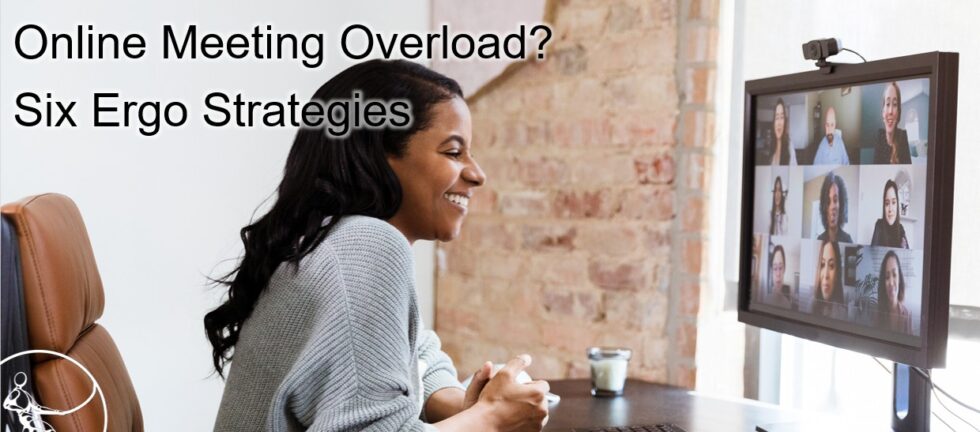Only a few years ago, virtual meetings were seen as a necessary evil. Meetings often started with audio problems and were frequently interrupted by connection issues. While tech issues haven’t disappeared completely, they don’t frazzle us as much as they used to. Virtual meetings are now viewed more favorably as a way to make better connections than email or phone, without the need for travel.
Some of us spend hours every day in these meetings, leading to prolonged periods spent in one position, focusing on interpreting verbal and non-verbal messages. The physical and cognitive strain associated with these meetings can be significant. How can virtual meetings be made more “ergonomic”? Here are six suggestions:
- Purposely Schedule Breaks Between Meetings
Most of us sit very still during meetings, and while you might not think sitting still is difficult, your body disagrees. Start meetings at 8:05 or finish by 8:25, for example, to ensure you have a few minutes to get up, move around, or organize your notes before the next meeting.
Lead by example by opening or closing meetings with a posture break. (Need ideas? Check out our “Move It” package.) Incorporating dynamic movement into your routine can reduce fatigue and promote circulation. If you have a sit-stand desk, meetings are the perfect opportunity to use it. Alternating between sitting and standing allows for subtle movements and helps maintain a neutral posture, giving your back a break from prolonged sitting. Standing also allows you to be more animated and engaging during your meeting.
- Frame Yourself Well
As a meeting participant, it’s challenging to communicate effectively with the top of someone’s head! Your meeting partners will appreciate seeing your entire face, so adjust your position or camera to ensure your head is near the top of the screen. Center yourself on the screen, and make sure you can sit back in your chair to support your back. (Unlike the employee in the photo above!)
If you’re a demonstrative speaker, you’ll need room to wave your arms. (As ergonomists, we often need to show a posture or point out a feature on a chair or tool.) Position yourself or your webcam far enough away to allow some movement while staying within view. However, avoid being so far away that you look like you’re sitting on the far side of a concert hall. Proper framing not only enhances communication but also reduces the need for awkward postures that might strain your neck or back.
- Make “Eye Contact”
During an in-person meeting, it would be overtly rude to turn sideways to the speaker, but this often happens virtually. While true “eye contact” isn’t technically possible in a virtual meeting, you appear to look directly at your meeting partner when you focus on the webcam.
If the meeting is displayed on a screen separate from the webcam, you may seem distracted. Arrange your meeting space so you use the screen with an integrated webcam or a separate webcam positioned immediately above the screen you’ll be looking at. Ideally, place the relevant screen directly below the webcam for a better “eye contact” experience, and to avoid neck strain. Try to position your webcam so it is centered with your chair and keyboard, so you don’t twist your neck and back for the whole meeting.
“Eye contact” also depends on visibility. Glare on your glasses can prevent your meeting partner from seeing your eyes. Adjust your lighting and camera angle to ensure your eyes are clearly visible, reducing cognitive fatigue for both you and your meeting partner.
It’s still okay to take notes during a meeting, especially if minutes aren’t being taken. But if you type while someone is speaking, you might appear to be multitasking, rather than giving the speaker your full attention.
- Optimize Lighting for Comfort
If you’ve ever met with someone who looks like a protected witness in a true crime show, you’ll understand the importance of lighting. Avoid “backlighting” caused by lights or windows behind you, which can make you appear as a silhouette.
You wouldn’t hold an in-person meeting in a dark room, so create a welcoming environment with good lighting. The best lighting comes from above and behind your screen, but you may need to experiment to avoid glare if you wear glasses. Natural light is flattering but can create shadows if it comes from one side, and facing a window isn’t advisable when using a computer screen. Proper lighting reduces eye strain and helps participants focus on the content, rather than struggling to see you.
- Keep It Simple
I would never wish to be invited into a business associate’s bedroom, so I feel uncomfortable when job candidates take interviews in such environments. Similarly, an open door in the scene invites distractions from people and animals moving around.
The background of your meeting space should be professional and free of distractions. While virtual backgrounds can be helpful, they don’t work well with my curly hair or when I turn sideways to demonstrate something. It’s worth investing time to create a “real” background that is uncluttered and professional.
Minimize background noise or use a headset to prevent disruptions from dogs, traffic, or kids. (Of course, in team meetings, we sometimes welcome our pets to check in!) A professional, distraction-free environment helps everyone focus and reduces cognitive strain, an essential element of ergonomics.
- Engage Actively
Presenters rely on cues from their audience to know if they’re hitting the mark. A presenter might pause, explain something differently, or skim through less engaging sections of a presentation.
Virtually presenting to a group of participants with their cameras off is challenging. The presenter is talking into a void, unable to gauge reactions.
As a presenter, ask questions to foster engagement. Keep the chat window open and encourage feedback there—some participants may be more comfortable engaging in writing. Explore interactive tools that video platforms now offer, such as polls, chat rooms, screen sharing, and reactions.
As a participant, remember that the presenter needs your input to create meaningful connections. Using your camera helps. If you can’t turn your camera on, make an effort to engage verbally, in writing, or by using reaction tools. Active engagement not only improves the meeting’s effectiveness but also keeps you mentally and physically engaged, preventing fatigue.
Perform an Ergo Audit
During your next virtual meeting, encourage participants to audit their meeting setups from an ergonomics perspective. Consider:
Is your chair adjusted to maintain a neutral posture?
Are your monitor and webcam positioned at eye level and aligned with your chair and keyboard, to prevent neck strain?
Is your lighting adequate to reduce eye strain and improve visibility?
Do you have the flexibility to alternate between sitting and standing, or move around a bit?
We’ve learned a lot about virtual meetings over the past few years. Making these sessions more “ergonomic” is possible with some planning. By incorporating ergonomics principles, you can protect your health, improve engagement, and ensure a productive and comfortable experience for everyone involved.


